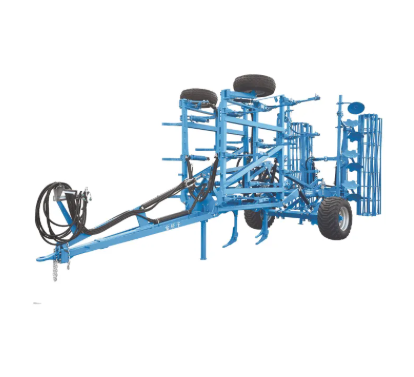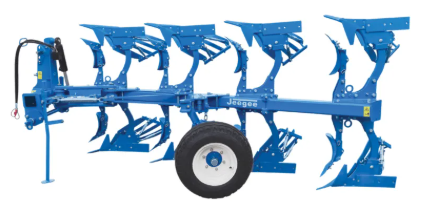Understanding Modern Sustainable Agriculture Through Advanced Ploughing Techniques
The agricultural sector stands at a crucial intersection between feeding the world's growing population and preserving our planet's delicate ecosystems. In this context, the reversible plough has emerged as a significant tool in sustainable farming practices. This innovative implement is revolutionizing how farmers approach soil management while minimizing environmental impact. As we delve deeper into sustainable agriculture methods, understanding the environmental implications of using a reversible plough becomes increasingly important for both farmers and environmental stewards.
The Mechanics and Operation of Reversible Ploughs
Core Components and Design Features
A reversible plough represents a masterpiece of agricultural engineering, featuring a unique design that allows it to turn soil in both directions. The implement consists of two sets of mouldboards mounted on a central beam, which can be rotated 180 degrees. This innovative design enables farmers to start at one side of the field and work continuously to the other, eliminating the need for circular ploughing patterns that often result in poor soil management.
The sophisticated hydraulic system in a reversible plough enables smooth transitions between ploughing directions, while the adjustable width settings allow farmers to adapt to different soil conditions and crop requirements. These technical features contribute significantly to both operational efficiency and environmental protection.
Operational Advantages in Field Applications
When operating a reversible plough, farmers can maintain straight furrows across the entire field, which proves particularly beneficial on sloping terrain. This precise operation reduces soil erosion by maintaining consistent furrow depths and proper water drainage patterns. The ability to plough in both directions also means less time spent on headlands, resulting in reduced soil compaction and fuel consumption.
Modern reversible plough systems often incorporate GPS technology and precision farming capabilities, allowing for optimal depth control and reduced overlap. This technological integration further enhances the environmental benefits while improving overall farming efficiency.

Soil Conservation and Structure Enhancement
Maintaining Soil Integrity
The reversible plough plays a crucial role in preserving soil structure through its unique turning action. Unlike conventional ploughs, it creates uniform furrows that promote better soil aggregation and reduce the risk of creating hardpan layers. This improved soil structure enables better root development and increases the soil's capacity to retain moisture and nutrients.
The implement's ability to maintain consistent ploughing depths helps preserve the natural soil horizons, which is essential for long-term soil health. This preservation of soil layers supports beneficial microorganism populations and enhances organic matter distribution throughout the soil profile.
Erosion Prevention and Management
One of the most significant environmental benefits of using a reversible plough is its contribution to erosion control. The even furrow pattern created helps manage water flow across fields, reducing surface runoff and soil loss during heavy rainfall events. This is particularly important in areas prone to water erosion or on sloping terrain where soil conservation is a primary concern.
The implement's ability to maintain level furrows also helps prevent wind erosion by keeping crop residue more evenly distributed across the field surface. This creates a more stable soil environment that resists both water and wind erosion throughout the growing season.
Impact on Water Management and Conservation
Enhanced Water Infiltration Patterns
The uniform furrow system created by a reversible plough significantly improves water infiltration into the soil profile. This enhanced water movement helps reduce surface pooling and promotes deeper moisture penetration, which is crucial for crop root development and drought resistance. The improved soil structure also helps maintain optimal moisture levels throughout the growing season.
Better water infiltration leads to reduced runoff and less soil erosion, while also helping to recharge groundwater supplies. This efficient water management is increasingly important as climate change brings more extreme weather patterns and water scarcity concerns.
Drainage System Optimization
Reversible plough usage contributes to better field drainage patterns through consistent furrow creation. This improved drainage helps prevent waterlogging and reduces the risk of soil compaction during wet conditions. Proper drainage also supports earlier field access in spring, allowing for timely planting and reduced soil structure damage.
The systematic approach to field preparation with a reversible plough also complements artificial drainage systems, enhancing their effectiveness and longevity. This integration of ploughing patterns with drainage infrastructure represents a holistic approach to water management in sustainable agriculture.
Carbon Footprint and Emissions Considerations
Fuel Efficiency and Operating Costs
The reversible plough's design promotes fuel efficiency through reduced turning requirements and optimal field coverage. The ability to plough continuously from one side of the field to the other eliminates unnecessary passes and reduces overall fuel consumption. This improved efficiency directly translates to lower carbon emissions and operating costs.
Modern reversible ploughs often incorporate features that automatically adjust working depth and width, further optimizing fuel usage. These adaptations ensure that the implement operates at peak efficiency regardless of soil conditions or terrain variations.
Carbon Sequestration Potential
When used as part of a comprehensive soil management strategy, the reversible plough can contribute to increased carbon sequestration in agricultural soils. The improved soil structure and enhanced organic matter incorporation help lock carbon into the soil profile, supporting long-term carbon storage and soil fertility.
The implement's ability to manage crop residue effectively also plays a role in carbon cycling, helping to maintain a balance between decomposition and incorporation that supports both soil health and carbon storage objectives.
Frequently Asked Questions
How does a reversible plough differ from conventional ploughing methods?
A reversible plough features two sets of mouldboards that can be rotated, allowing continuous ploughing in the same direction across a field. This design eliminates the need for circular ploughing patterns and results in more uniform soil management, reduced compaction, and improved environmental outcomes compared to conventional ploughing methods.
What are the main environmental benefits of using a reversible plough?
The primary environmental benefits include reduced soil erosion, improved water infiltration, better soil structure preservation, decreased fuel consumption, and enhanced carbon sequestration potential. The implement's precise operation also helps maintain biodiversity and supports sustainable farming practices.
How does a reversible plough contribute to water conservation?
Reversible ploughs create uniform furrows that improve water infiltration and reduce surface runoff. This enhanced water management helps conserve moisture in the soil profile, reduces erosion, and supports more efficient irrigation practices while protecting water resources.

